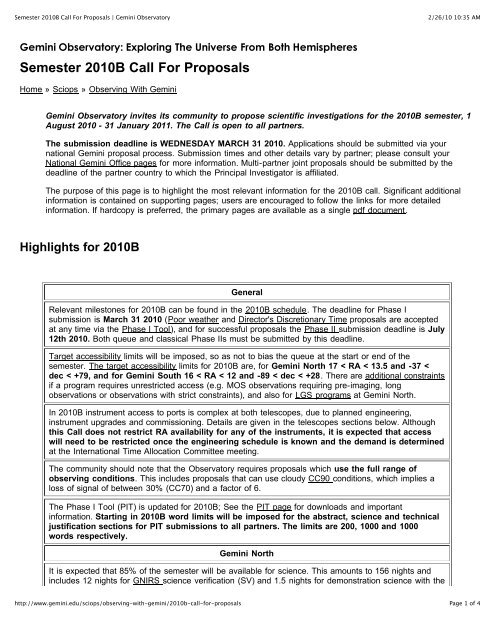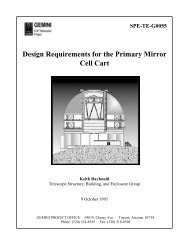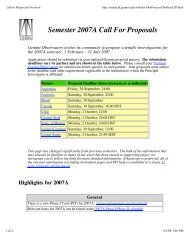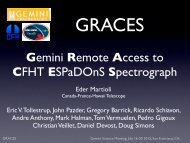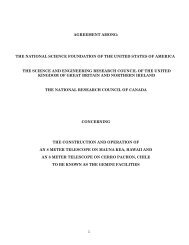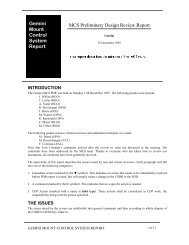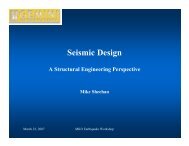pdf document - Gemini Observatory
pdf document - Gemini Observatory
pdf document - Gemini Observatory
Create successful ePaper yourself
Turn your PDF publications into a flip-book with our unique Google optimized e-Paper software.
Semester 2010B Call For Proposals | <strong>Gemini</strong> <strong>Observatory</strong><br />
2/26/10 10:35 AM<br />
<strong>Gemini</strong> <strong>Observatory</strong>: Exploring The Universe From Both Hemispheres<br />
Semester 2010B Call For Proposals<br />
Home » Sciops » Observing With <strong>Gemini</strong><br />
<strong>Gemini</strong> <strong>Observatory</strong> invites its community to propose scientific investigations for the 2010B semester, 1<br />
August 2010 - 31 January 2011. The Call is open to all partners.<br />
The submission deadline is WEDNESDAY MARCH 31 2010. Applications should be submitted via your<br />
national <strong>Gemini</strong> proposal process. Submission times and other details vary by partner; please consult your<br />
National <strong>Gemini</strong> Office pages for more information. Multi-partner joint proposals should be submitted by the<br />
deadline of the partner country to which the Principal Investigator is affiliated.<br />
The purpose of this page is to highlight the most relevant information for the 2010B call. Significant additional<br />
information is contained on supporting pages; users are encouraged to follow the links for more detailed<br />
information. If hardcopy is preferred, the primary pages are available as a single <strong>pdf</strong> <strong>document</strong>.<br />
Highlights for 2010B<br />
General<br />
Relevant milestones for 2010B can be found in the 2010B schedule. The deadline for Phase I<br />
submission is March 31 2010 (Poor weather and Director's Discretionary Time proposals are accepted<br />
at any time via the Phase I Tool), and for successful proposals the Phase II submission deadline is July<br />
12th 2010. Both queue and classical Phase IIs must be submitted by this deadline.<br />
Target accessibility limits will be imposed, so as not to bias the queue at the start or end of the<br />
semester. The target accessibility limits for 2010B are, for <strong>Gemini</strong> North 17 < RA < 13.5 and -37 <<br />
dec < +79, and for <strong>Gemini</strong> South 16 < RA < 12 and -89 < dec < +28. There are additional constraints<br />
if a program requires unrestricted access (e.g. MOS observations requiring pre-imaging, long<br />
observations or observations with strict constraints), and also for LGS programs at <strong>Gemini</strong> North.<br />
In 2010B instrument access to ports is complex at both telescopes, due to planned engineering,<br />
instrument upgrades and commissioning. Details are given in the telescopes sections below. Although<br />
this Call does not restrict RA availability for any of the instruments, it is expected that access<br />
will need to be restricted once the engineering schedule is known and the demand is determined<br />
at the International Time Allocation Committee meeting.<br />
The community should note that the <strong>Observatory</strong> requires proposals which use the full range of<br />
observing conditions. This includes proposals that can use cloudy CC90 conditions, which implies a<br />
loss of signal of between 30% (CC70) and a factor of 6.<br />
The Phase I Tool (PIT) is updated for 2010B; See the PIT page for downloads and important<br />
information. Starting in 2010B word limits will be imposed for the abstract, science and technical<br />
justification sections for PIT submissions to all partners. The limits are 200, 1000 and 1000<br />
words respectively.<br />
<strong>Gemini</strong> North<br />
It is expected that 85% of the semester will be available for science. This amounts to 156 nights and<br />
includes 12 nights for GNIRS science verification (SV) and 1.5 nights for demonstration science with the<br />
http://www.gemini.edu/sciops/observing-with-gemini/2010b-call-for-proposals<br />
Page 1 of 4
Semester 2010B Call For Proposals | <strong>Gemini</strong> <strong>Observatory</strong><br />
2/26/10 10:35 AM<br />
upgraded GMOS-N. These nights are distributed across the partnership. A list of instruments and<br />
capabilities is given below.<br />
A later call will be made for SV proposals for GNIRS.<br />
GMOS-North is expected to be available with new red-sensitive CCDs from 1 December 2010.<br />
Proposals are welcomed which can take advantage of the improved red response, and the new Z and Y<br />
filters, for targets with 2 < RA < 13.5. Proposals for which the improved red response is necessary<br />
should not be submitted for targets with 17 < RA < 2. The Integration Time Calculator will be available<br />
for both the new and old detectors. Time requests for targets with 17 < RA < 2 should be based on the<br />
old detectors, and those for targets with 2 < RA < 13.5 should be based on the new detectors. The<br />
instrument will be unavailable for a four week period during the detector upgrade.<br />
Michelle will most likely only be available for two short periods during the semester, depending on<br />
demand.<br />
<strong>Gemini</strong> South<br />
It is expected that 76% of the time will be available for science use on <strong>Gemini</strong> South in 2010B. This<br />
amounts to 140 nights, and includes 18 nights of NICI campaign science. These nights are distributed<br />
across the partnership. A list of instruments and capabilities is given below. Due to the need to balance<br />
the queue, and the traditionally high demand for GMOS-S dark time programs, bright time programs on<br />
<strong>Gemini</strong> South are particularly encouraged.<br />
The telescope will be shut down for 24 nights for mirror coating, probably during September to October<br />
2010.<br />
Phoenix and T-ReCS may be unavailable late in the semester (not before November 2010) due to<br />
MCAO commissioning.<br />
NICI, the AO-fed Near-Infrared Coronagraphic Imager, will be available to the community in 2010B in<br />
the L band, on a shared risk basis. The M band is not useful due to saturation when using the<br />
broadband filter. Note that the good observing conditions required for NICI are much more likely in the<br />
second half of the semester. See below for other restrictions.<br />
Exchange<br />
Up to 5 bright/gray nights of classical time are available with the HIRES optical spectrograph on Keck.<br />
The requested nights must be within the following windows with a minimum of 1 and a maximum of<br />
2 nights in any one window: August 17 - 30, October 16 - 27 and December 14 - 25. Proposals<br />
should be submitted via the normal <strong>Gemini</strong> process. All proposers for Keck time must also complete the<br />
Keck cover page. Email this page to your NTAC chair. [more information]<br />
5 to 10 classical nights are available on Subaru with COMICS (mid-infrared camera and<br />
spectrograph), FOCAS (optical faint object camera and spectrograph), HDS (optical high dispersion<br />
spectrograph), IRCS (infrared camera and spectrograph, with Natural Guide Star Adaptive Optics<br />
capability), MOIRCS (near-infrared imager and multi-object spectrograph) and Suprime-Cam (wide field<br />
optical imager). The Subaru nights will be distributed across bright, grey and dark periods with typically<br />
2 or 3 nights in each of these moon phases, depending on the total number of nights allocated. A<br />
minimum of 1 and a maximum of 4 nights can be requested in the following windows only:<br />
bright - October 17 - 26 or December 16 - 24,<br />
grey - December 11 - 15,<br />
dark - November 2 - 8 or December 31 - January 6.<br />
The final schedule is dependent on allocation and instrument availability. Note that Subaru may be<br />
closed between August and September. Proposals should be submitted via the normal <strong>Gemini</strong> process.<br />
[more information]<br />
http://www.gemini.edu/sciops/observing-with-gemini/2010b-call-for-proposals<br />
Page 2 of 4
Semester 2010B Call For Proposals | <strong>Gemini</strong> <strong>Observatory</strong><br />
2/26/10 10:35 AM<br />
Additional Information<br />
Details of the capabilities available at each <strong>Gemini</strong> telescope are given below. Please see the page of supporting<br />
information for additional general information.<br />
<strong>Gemini</strong> North: Facilities<br />
All instruments are offered in queue and classical mode, except for Laser Guide Star AO which<br />
is queue mode only.<br />
Facility instruments:<br />
GMOS North - 0.36-1.10 micron imager and spectrograph: imaging and long-slit, multiobject<br />
and integral field spectroscopy. 5! one hour point source sensitivities are<br />
approximately R=26 for imaging and R=21-23 for spectroscopy.<br />
NIRI - 1-5 micron imager and low-resolution spectrograph: imaging and spectroscopy<br />
fed with the direct or AO-corrected beam. 5! one hour point source sensitivities are<br />
approximately K=23 for imaging and K=18 for spectroscopy.<br />
NIFS - 0.95-2.40 micron integral field unit spectrograph: IFU spectroscopy fed with the<br />
direct or AO-corrected beam. 5! one hour point source sensitivities are approximately<br />
K=18.7.<br />
Altair - facility AO system: for use with NIRI (except M band imaging and L & M band<br />
spectroscopy) and NIFS.<br />
Natural Guide Star AO: Traditional adaptive optics guiding on a nearby star.<br />
See the Laser Guide Star AO web pages for important performance information and<br />
restrictions. Note that LGS observations must specify "Laser guide star" in the AO<br />
resources section in the PIT, and must request Cloud Cover = 50% and Image<br />
Quality = 70%. Faint tip tilt stars will also require darker skies: 17.5 < R < 18 needs<br />
SB=80%, 18 < R < 18.5 needs SB=50%.<br />
Michelle - 7-26 micron spectrograph and imager: imaging and R=100-3000 and echelle<br />
spectroscopy; imaging polarimetry is also available. 5! one hour point source sensitivities<br />
are approximately N=11 for imaging and N=6-9 for spectroscopy.<br />
See the target accessibility page for important information regarding instrument availability and a plot<br />
of accessible RA and Declination. For Semester 2010B targets must be limited to 17 < RA < 13.5,<br />
and -37 < dec < +79, the LGS system has a stricter elevation constraint of >40 degrees.<br />
<strong>Gemini</strong> South: Facilities<br />
All instruments are offered in queue and classical mode.<br />
Facility instruments:<br />
GMOS South - 0.36-0.95 micron imager and spectrograph: imaging and long-slit, multiobject<br />
and integral field spectroscopy. 5! one hour point source sensitivities are<br />
approximately R=26 for imaging and R=21-23 for spectroscopy. GMOS South has slightly<br />
better sensitivity in the UV and blue than GMOS North.<br />
NICI - 1-5 micron dual-channel coronagraphic imager: In 2010B NICI is offered for<br />
community use for both coronagraphic and non-coronagraphic imaging. The L band is<br />
http://www.gemini.edu/sciops/observing-with-gemini/2010b-call-for-proposals<br />
Page 3 of 4
Semester 2010B Call For Proposals | <strong>Gemini</strong> <strong>Observatory</strong><br />
2/26/10 10:35 AM<br />
available on a shared risk basis. AO guiding on extended targets (up to 0.8") is available<br />
on a shared risk basis. For coronagraphic imaging the occulted target should also be the<br />
AO guide target. The Campaign Targets are not available for community NICI<br />
observations. Constraints must be at least as good as Cloud Cover = 50% and Image<br />
Quality = 70%.<br />
T-ReCS - 8-26 micron imager and spectrograph: imaging and moderate resolution<br />
(R=100 and R=1000) spectroscopy. 5! one hour point source sensitivities are<br />
approximately N=11 for imaging and N=8 for spectroscopy .<br />
Visitor instruments:<br />
Phoenix - 1-5 micron high spectral resolution (R~50000 - 75000) spectrometer. 5!<br />
one hour point source sensitivities are approximately K=12.5.<br />
See the target accessibility page for important information regarding instrument availability and a<br />
plot of accessible RA and Declination. For Semester 2010B targets must be limited to 16 <<br />
RA < 12, and -89 < dec < +28.<br />
Questions and Answers<br />
All questions concerning proposals, or any other subject, should be made using the <strong>Gemini</strong> HelpDesk. This webbased<br />
system will send the request to your National <strong>Gemini</strong> Office staff in the first instance who will then<br />
escalate it to <strong>Gemini</strong> staff if necessary.<br />
Comments and suggestions on the format and content of this page and supporting pages are welcome, and<br />
should be sent to Sandy Leggett.<br />
Any opinions, findings, and conclusions or recommendations expressed in this material are those of the author(s) and<br />
do not necessarily reflect the views of the National Science Foundation.<br />
The <strong>Gemini</strong> <strong>Observatory</strong> is operated by the Association of Universities for Research in Astronomy, Inc., under a<br />
cooperative agreement with the NSF on behalf of the <strong>Gemini</strong> partnership: the National Science Foundation (United<br />
States), the Science and Technology Facilities Council (United Kingdom), the National Research Council (Canada),<br />
CONICYT (Chile), the Australian Research Council (Australia), Ministério da Ciência e Tecnologia (Brazil), and<br />
Ministerio de Ciencia, Tecnología e Innovación Productiva (Argentina)<br />
http://www.gemini.edu/sciops/observing-with-gemini/2010b-call-for-proposals<br />
Page 4 of 4
Semester 2010B Time Distribution | <strong>Gemini</strong> <strong>Observatory</strong><br />
2/26/10 9:36 AM<br />
<strong>Gemini</strong> <strong>Observatory</strong>: Exploring The Universe From Both Hemispheres<br />
Semester 2010B Time Distribution<br />
Home » Sciops » Observing With <strong>Gemini</strong> » 2010B Call For Proposals<br />
<strong>Gemini</strong> North: Time Availability and Distribution<br />
A minimum of 85% of the time will be available for science use on <strong>Gemini</strong> North in 2010B. This amounts to 156 nights<br />
and includes 12 nights for GNIRS science verification (SV) and 1.5 nights for demonstration science with the upgraded<br />
GMOS-N. The remaining time will be used for observatory maintenance tasks, and the planned commissioning of<br />
GNIRS and the new CCDs for GMOS-N; any unused engineering time will be returned to science. Note that historically<br />
around 5% of each semester's science time is used to complete highly ranked programs from the previous two<br />
semesters to which the ITAC granted rollover status. The number of hours allocated to each partner in 2010B is given<br />
in the following table.<br />
Partner<br />
Estimated Hours Available<br />
US 608<br />
UK 263<br />
Canada 143<br />
Australia 59<br />
Argentina 22<br />
Brazil 60<br />
Univ. of Hawaii (host) 157<br />
<strong>Gemini</strong> Staff 117<br />
Total<br />
1429 (=143n)<br />
<strong>Gemini</strong> South: Time Availability and Distribution<br />
A minimum of 76% of the time will be available for science use on <strong>Gemini</strong> South in 2010B. This amounts to 140 nights,<br />
and includes 18 nights of NICI campaign science. The remaining time will be used for observatory maintenance tasks,<br />
and Flamingos-2 and MCAO commissioning activities. Any unused engineering time will be returned to science. Note<br />
that historically around 5% of each semester's science time is used to complete highly ranked programs from the<br />
previous two semesters to which the ITAC granted rollover status. The number of hours allocated to each partner in<br />
2010B is given in the following table.<br />
Partner<br />
Estimated Hours Available<br />
US 526<br />
UK 222<br />
http://www.gemini.edu/sciops/observing-with-gemini/2010b-call-for-proposals/time-distribution<br />
Page 1 of 2
Semester 2010B Time Distribution | <strong>Gemini</strong> <strong>Observatory</strong><br />
2/26/10 9:36 AM<br />
Canada 117<br />
Australia 60<br />
Argentina 22<br />
Brazil 61<br />
Chile (host) 108<br />
<strong>Gemini</strong> Staff 103<br />
Total<br />
1219 (=122n)<br />
Time Adjustments<br />
To maintain overall balance amongst the partnership, the values shown above for both <strong>Gemini</strong> North and South have<br />
been adjusted from the nominal partner shares as a result of actual time charged through 2009B. The time allocations<br />
also include a purchase by Brazil of 35 hours of UK time at each telescope. The values shown in the tables above<br />
were recommended by the Operations Working Group in February 2010. The number of nights is approximated by<br />
int(hours/10).<br />
Any opinions, findings, and conclusions or recommendations expressed in this material are those of the author(s) and<br />
do not necessarily reflect the views of the National Science Foundation.<br />
The <strong>Gemini</strong> <strong>Observatory</strong> is operated by the Association of Universities for Research in Astronomy, Inc., under a<br />
cooperative agreement with the NSF on behalf of the <strong>Gemini</strong> partnership: the National Science Foundation (United<br />
States), the Science and Technology Facilities Council (United Kingdom), the National Research Council (Canada),<br />
CONICYT (Chile), the Australian Research Council (Australia), Ministério da Ciência e Tecnologia (Brazil), and<br />
Ministerio de Ciencia, Tecnología e Innovación Productiva (Argentina)<br />
http://www.gemini.edu/sciops/observing-with-gemini/2010b-call-for-proposals/time-distribution<br />
Page 2 of 2
2010B Instrument Availability and Target Accessibility | <strong>Gemini</strong> <strong>Observatory</strong><br />
2/26/10 10:36 AM<br />
<strong>Gemini</strong> <strong>Observatory</strong>: Exploring The Universe From Both Hemispheres<br />
2010B Instrument Availability and Target Accessibility<br />
Home » Sciops » Observing With <strong>Gemini</strong> » 2010B Call For Proposals<br />
This page provides best estimates, at the time of the Call for Proposals, of instrument availability and target (RA, dec)<br />
restrictions for 2010B.<br />
Instrument Changes<br />
As there are more instruments than the number of available ports on each telescope, instrument swaps will be<br />
required. Therefore not all instruments will be available for the entire semester. When possible instrument swaps will be<br />
scheduled to minimize impact on the queue and instrument swaps will be driven by demand. Hence the final schedule<br />
will not be made until after the semester programs are known. It may be the case that certain targets or entire<br />
programs will not be feasible once the final schedule is determined, at ITAC or thereafter. If an instrument is requested<br />
for less than 6% of the Bands 1+2 time, the <strong>Observatory</strong> reserves the right to limit the RA range available to programs,<br />
or to not schedule the instrument. During classical runs, no instrument changes on the Instrument Support Structure<br />
are permitted.<br />
In 2010B instrument access to ports is especially complex at both telescopes, due to planned engineering, instrument<br />
upgrades and commissioning. Although this Call does not restrict RA availability for any of the instruments, it is<br />
expected that access will need to be restricted once the engineering schedule is known and the demand is<br />
determined at the International Time Allocation Committee meeting.<br />
<strong>Gemini</strong> North Instrument Availability and Target Accessibility<br />
All instruments are restricted for sky visibility as described in the Table and Figure below. Observations<br />
requiring the Laser Guide Star (LGS) system are further restricted by the limitation that the LGS must be used at or<br />
above 40 degrees elevation. How this translates into RA and dec restrictions is indicated in the Table. In addition in<br />
2010B, GMOS-North is expected to be unavailable for a four week period for the detector upgrade. Michelle will most<br />
likely only be available for two short periods during the semester, depending on demand.<br />
Accessible Restricted ** Inaccessible<br />
Declination,<br />
non-LGS<br />
-30d to +73d<br />
-37d to -30d,<br />
+73d to +79d<br />
< -37d and > +79d<br />
Declination,<br />
LGS<br />
-22d to +65d<br />
-27d to -22d,<br />
+65d to +68d<br />
< -27d and > +68d<br />
Right Ascension,<br />
non-LGS<br />
19h to 11h<br />
17h to 19h,<br />
11h to 13.5h<br />
13.5h to 17h<br />
Right Ascension,<br />
LGS<br />
20h to 10h<br />
18h to 20h,<br />
10h to 12.5h<br />
12.5h to 18h<br />
** GMOS MOS programs requiring pre-imaging should not have targets in this region. Programs with targets in this<br />
region should not require a large amount of time, or have strict timing or observing constraints.<br />
http://www.gemini.edu/sciops/observing-with-gemini/2010b-call-for-proposals?q=node/11407<br />
Page 1 of 4
2010B Instrument Availability and Target Accessibility | <strong>Gemini</strong> <strong>Observatory</strong><br />
2/26/10 10:36 AM<br />
Figure 1: Schematic representation of target accessibility at <strong>Gemini</strong> North during semester 2010B. Green regions offer<br />
unrestricted access, red regions are inaccessible. Hatched areas indicate the more restricted LGS regions. The yellow<br />
region is possible, but restricted. See text, and values in the Table above.<br />
<strong>Gemini</strong> South Instrument Availability and Target Accessibility<br />
All instruments are restricted for sky visibility as described in the Table and Figure below. In addition in 2010B,<br />
Phoenix and T-ReCS may be unavailable late in the semester (not before November 2010) due to MCAO<br />
commissioning. The telescope will be shut down for 24 nights for mirror coating, probably during September to October<br />
2010.<br />
http://www.gemini.edu/sciops/observing-with-gemini/2010b-call-for-proposals?q=node/11407<br />
Page 2 of 4
2010B Instrument Availability and Target Accessibility | <strong>Gemini</strong> <strong>Observatory</strong><br />
2/26/10 10:36 AM<br />
Accessible Restricted ** Inaccessible<br />
Declination -87d to +22d<br />
-89d to -87d,<br />
+22d to +28d<br />
< -89d and > +28d<br />
Right Ascension<br />
19h to 9h<br />
16h to 19h,<br />
9h to 12h<br />
12h to 16h<br />
** GMOS MOS programs requiring pre-imaging should not have targets in this region. Programs with targets in this<br />
region should not require a large amount of time, or have strict timing or observing constraints.<br />
Figure 2: Schematic representation of target accessibility at <strong>Gemini</strong> South during semester 2010B. Green regions offer<br />
unrestricted access, red regions are inaccessible. The yellow region is possible, but restricted. See text, and values in<br />
the Table above.<br />
http://www.gemini.edu/sciops/observing-with-gemini/2010b-call-for-proposals?q=node/11407<br />
Page 3 of 4
Semester 2010B Important Dates | <strong>Gemini</strong> <strong>Observatory</strong><br />
2/26/10 9:37 AM<br />
<strong>Gemini</strong> <strong>Observatory</strong>: Exploring The Universe From Both Hemispheres<br />
Semester 2010B Important Dates<br />
Home » Sciops » Observing With <strong>Gemini</strong> » 2010B Call For Proposals<br />
Key dates and events in the proposal process are shown below. The Phase I and Phase II deadlines are highlighted.<br />
Date Event Comments<br />
31 March 2010 Proposal deadline Proposals received by National <strong>Gemini</strong> Offices<br />
(NGOs) - see partner pages.<br />
Set by partner NTAC meetings Separate scientific and technical assessments by each<br />
<strong>Gemini</strong> partner ("National TACs").<br />
On or before 13 May 2010 E-transmission Electronic transmission of proposals to <strong>Gemini</strong> from<br />
NTACs<br />
26-27 May 2010 ITAC International Time Allocation Committee meets to resolve<br />
issues and recommend programs.<br />
7 June 2010 Final queue/schedule, and<br />
ITAC & <strong>Gemini</strong> feedback to<br />
NGOs<br />
14 June 2010 10B schedule and Phase<br />
IIs available<br />
After approval by <strong>Gemini</strong> Director.<br />
2010B OT released, "skeletons" available.<br />
2 July 2010 Phase II reviews start The response time is 7 days for checking by NGOs<br />
(from "For Review") and by <strong>Gemini</strong> CSs (from "For<br />
Activation").<br />
12 July 2010 Phase II deadline PI deadline for submission of completed Phase II<br />
Programs to National Offices (earlier submission is<br />
encouraged).<br />
26 July 2010 "For Activation" deadline NGO deadline for submission of completed Phase II<br />
Programs to <strong>Gemini</strong>.<br />
01 August 2010 Start of semester 2010B 2010B programs may be observed earlier to fill queue<br />
nights.<br />
Any opinions, findings, and conclusions or recommendations expressed in this material are those of the author(s) and<br />
do not necessarily reflect the views of the National Science Foundation.<br />
The <strong>Gemini</strong> <strong>Observatory</strong> is operated by the Association of Universities for Research in Astronomy, Inc., under a<br />
cooperative agreement with the NSF on behalf of the <strong>Gemini</strong> partnership: the National Science Foundation (United<br />
States), the Science and Technology Facilities Council (United Kingdom), the National Research Council (Canada),<br />
CONICYT (Chile), the Australian Research Council (Australia), Ministério da Ciência e Tecnologia (Brazil), and<br />
Ministerio de Ciencia, Tecnología e Innovación Productiva (Argentina)<br />
http://www.gemini.edu/sciops/observing-with-gemini/2010b-call-for-proposals/important-dates<br />
Page 1 of 1
Call for Proposals Supporting Information | <strong>Gemini</strong> <strong>Observatory</strong><br />
2/23/10 2:43 PM<br />
<strong>Gemini</strong> <strong>Observatory</strong>: Exploring The Universe From Both Hemispheres<br />
Call for Proposals Supporting Information<br />
Home » Sciops » Observing With <strong>Gemini</strong><br />
This page contains information on the following topics relevant to applying for time on <strong>Gemini</strong>. The information is<br />
general in nature, for details specific to the upcoming semester, please see the current call for proposals.<br />
Time Allocation Process (National and International Time Allocation Committees)<br />
Submitting for time on both telescopes<br />
Queue Rollover<br />
Electronic PIT Submission<br />
Joint Proposals<br />
Under-utilized Instruments<br />
Rapid Response or Target of Opportunity<br />
GMOS Mask definitions<br />
Poor Weather Programs<br />
Exchange Time<br />
Target information (guide stars, non-sidereal objects, time-specific observations)<br />
Duplicate Observations<br />
Time Allocation Process<br />
An overview of the proposal submission and time allocation process is given here. The assessment and ranking<br />
of proposals within each partner country will be via National Time Allocation Committees (NTACs) supported by<br />
the National <strong>Gemini</strong> Offices. Assembly of the final semester schedule and queue, definition of scientific ranking<br />
bands and resolution of conflicts and joint proposals between partners is done by the International Time<br />
Allocation Committee (ITAC).<br />
Submissions to Use Multiple Telescopes<br />
Each observing proposal may request resources from a single telescope only (<strong>Gemini</strong> North, <strong>Gemini</strong><br />
South, Keck or Subaru). Proposals for multiple telescopes are no longer permitted, and the Phase I tool will not<br />
allow resources from multiple telescopes to be selected. Proposals may include the use of multiple instruments<br />
on the same telescope. If a program requires resources from multiple telescopes, separate proposals must be<br />
submitted for each telescope; in this case, each proposal should clearly reference the other(s). The proposals<br />
will be ranked and scheduled independently. Proposals that can be carried out with either GMOS (note that they<br />
have different capabilities) must nevertheless specify one of them; the NTACs or ITAC may make changes.<br />
Queue Rollover<br />
Programs assigned by the ITAC into Band 1 are eligible for rollover into the next semester, for no more than two<br />
consecutive semesters, in order to increase the likelihood of program completion. Rollover status will be<br />
assigned by the ITAC. Programs with rollover status will automatically be carried forward for up to 2 semesters<br />
until their time allocation is exhausted, i.e. PIs need not re-apply if the currently approved allocation is sufficient<br />
to reach the science goals of the program. Target of Opportunity programs are not given rollover status. National<br />
policies that affect eligibility are defined by the relevant NTAC.<br />
http://sciopsedit.gemini.edu/sciops/observing-with-gemini/call-proposals-supporting-information<br />
Page 1 of 4
Call for Proposals Supporting Information | <strong>Gemini</strong> <strong>Observatory</strong><br />
2/23/10 2:43 PM<br />
Electronic Submission<br />
All partners support electronic submission of proposals from within the <strong>Gemini</strong> Phase I Tool (PIT). In the US,<br />
submission of non-joint proposals using the NOAO web form continues to be supported. Versions of the PIT are<br />
created for each semester, including new features described in PIT Hot News.<br />
Joint Proposals<br />
If you submit the same proposal to several partner countries a "joint proposal" you must do so using PIT. The<br />
PIT software, and backend servers installed at each National Office, allow automatic ("one-click") submission of<br />
the same proposal to multiple partners. Joint proposals should be submitted by the deadline of the partner<br />
country to which the Principal Investigator is affiliated.<br />
Under-Utilized Instruments<br />
Community demand is a critical factor in determining instrument availability. Each instrument introduces<br />
significant overhead to the <strong>Observatory</strong>, and access to instrument ports is at a premium. If an instrument is<br />
requested for less than 6% of the Bands 1+2 time, the <strong>Observatory</strong> reserves the right to limit the RA range<br />
available to programs, or to not schedule the instrument.<br />
Rapid Response or Target of Opportunity programs<br />
We continue to encourage Target of Opportunity (ToO) programs (formerly called "Quick Response"), intended to<br />
allow observation of targets that cannot be specified in advance but which have a well defined external trigger<br />
(e.g., Supernovae or Gamma Ray Bursts which will be identified throughout the observing semester by non-<br />
<strong>Gemini</strong> programs). "ToO" mode may be requested with any facility instrument. Proposals for ToO mode should<br />
be made via the normal proposal process and must select the type of trigger in the PIT and summarise the<br />
trigger event (e.g. identification of a target brighter than a pre-determined threshold) in the proposal abstract.<br />
ToO covers trigger types from several months to minutes in response time. Two types of ToO triggers are<br />
defined: "Rapid Response" and "Standard" which differ by response time. Rapid response programs must be<br />
allocated time in Band 1. ToO programs will not be given rollover status.<br />
Gamma Ray Burst (GRB) programs: in previous semesters many separate proposals for Gamma Ray Burst<br />
follow-up studies were submitted to the NTACs and a subset were forwarded to ITAC. As in those semesters,<br />
the ITAC and <strong>Observatory</strong> will seek to combine or otherwise substitute such proposals, e.g. by forming<br />
partnerships or time-division strategies, so that only one proposal is active on each telescope at any time.<br />
Applicants for GRB studies are strongly encouraged to coordinate their proposals before submission. The<br />
<strong>Observatory</strong> and ITAC reserve the right to form umbrella programs based on the proposals forwarded by the<br />
NTACs.<br />
GMOS Mask Definition<br />
Mask making from non-GMOS images for GMOS multi-object spectroscopy (MOS) observations is available, but<br />
GMOS pre-imaging is recommended for MOS programs using slits narrower than 1.0" and for programs<br />
requiring very long observations of faint targets. If pre-imaging is required, then sufficient pre-imaging time<br />
should be included in the proposal. For classical programs, pre-imaging will be scheduled in the queue. Any<br />
unused pre-imaging time will be returned to the program.<br />
Poor Weather Proposals<br />
Often the queue contains insufficient proposals for the poorest conditions, despite the best efforts of the National<br />
TACs to pass on a balanced package of proposals to <strong>Gemini</strong>. To encourage submission of more proposals in<br />
this category, those with the observing condition constraints specified below will receive special consideration at<br />
the TACs. If the programs are ranked lower than band 3 they may be placed in a "Poor Weather Queue" (Band<br />
http://sciopsedit.gemini.edu/sciops/observing-with-gemini/call-proposals-supporting-information<br />
Page 2 of 4
Call for Proposals Supporting Information | <strong>Gemini</strong> <strong>Observatory</strong><br />
2/23/10 2:43 PM<br />
4) and neither the PI nor partner country will be charged for any time used. Note however that poor weather<br />
programs are lower in priority than scientific ranking band 3. Poor weather programs may be submitted for any<br />
facility instrument but the observing constraints must match one of the following:<br />
Image Quality of "any" and Cloud Cover of 70%-ile or worse (non-photometric)<br />
Cloud Cover of 90%-ile (typically 2 magnitudes of cloud cover and unusable in the mid-IR) and any other<br />
combination of conditions<br />
Water Vapour constraints for all poor weather proposals need to be set to "any". The Sky Background constraint<br />
can be specified and it is acceptable for these programs to request dark time.<br />
Poor weather programs can now be submitted at any time in the semester. Use the Phase I tool to submit your<br />
proposal, selecting "Poor weather" from the drop down menu in the Submit tab. Such programs will be<br />
automatically placed in the Band 4 "Poor Weather Queue".<br />
Exchange Time<br />
<strong>Gemini</strong> <strong>Observatory</strong> encourages fruitful exchanges with other major observatories in order to expand the<br />
instrument capabilities available to the <strong>Gemini</strong> community. At present, the <strong>Observatory</strong> has two exchange<br />
programs in place. The first agreement is an exchange of classical nights for HIRES time on the Keck I<br />
telescope in exchange for classical nights with NIRI and Michelle on <strong>Gemini</strong> North or T-ReCS on <strong>Gemini</strong> South.<br />
See the Keck time application page for information on applying for the <strong>Gemini</strong> time through Keck. The second<br />
agreement is for classical nights on Subaru in exchange for classical nights with <strong>Gemini</strong>. The Subaru<br />
instruments currently available to the <strong>Gemini</strong> community are COMICS, HDS, FOCAS and IRCS, MOIRCS and<br />
Suprime-Cam. In exchange, the Subaru community has access to both GMOS instruments (North and South),<br />
Michelle, NICI, NIRI, NIFS and T-ReCS. See the Subaru call for proposals for more information on applying for<br />
<strong>Gemini</strong> time through Subaru. The details of the amount of time currently available and other restrictions are<br />
provided in the current call for proposals.<br />
Target Information<br />
Time-specific (including periodic monitoring and follow-up) programs may be accepted on a best-efforts basis.<br />
Proposers should specify these time constraints in the PIT. Note that the instrument scheduling may impose<br />
additional restrictions on this class of programs.<br />
All observations require the use of one wavefront sensor (WFS) star for fast guiding, primary mirror active optics<br />
control and/or as an adaptive optics wavefront reference source. The specific requirements for each instrument<br />
are given in the relevant science instrument web pages. As the technical feasibility of proposals relies in part on<br />
the availability of WFS stars, all proposals with well-defined targets must include suitable WFS stars. Proposals<br />
to observe non-sidereal objects should indicate the likely availability of WFS stars in the technical justification but<br />
are not required to supply specific stars. Target of Opportunity programs do not need to define WFS stars. Nonsidereal<br />
tracking is available for all instruments. Non-sidereal tracking with GMOS is fully supported with the<br />
peripheral wavefront sensors and partially supported with the OIWFS.<br />
Duplicate Observations<br />
Proposers should check their observations against the <strong>Gemini</strong> Science Archive to ensure that similar or identical<br />
observations have not already been executed. The Phase I Tool includes a function to facilitate this. Any<br />
duplicate or seemingly duplicate observations should be well-justified in the proposal. The NTACs will consider<br />
duplication of existing observations as part of the proposal evaluation. The ITAC evaluates and resolves any<br />
duplication of targets (or potential duplication in the case of ToO observations) between proposals from different<br />
partner countries.<br />
http://sciopsedit.gemini.edu/sciops/observing-with-gemini/call-proposals-supporting-information<br />
Page 3 of 4


